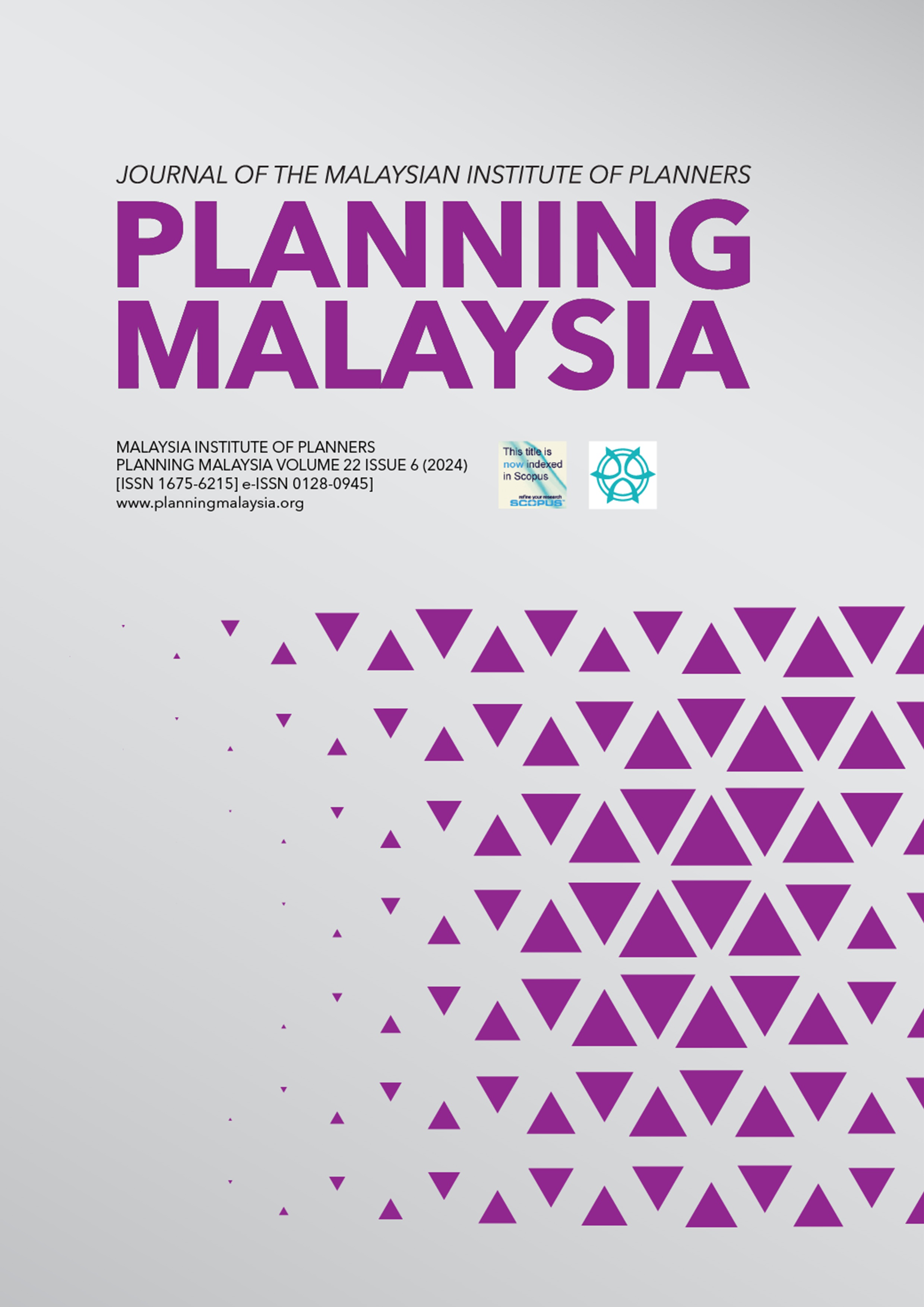EXAMINING RECYCLABLE ITEMS COLLECTION: INSIGHTS FROM MATERIAL RECOVERY COLLECTION FACILITY AND COMMUNITY RECYCLING CENTRE
DOI:
https://doi.org/10.21837/pm.v22i34.1656Keywords:
Recyclable, Material Recovery Collection Facility (MRCFs), Community Recycling Centre (CFCs), KDEB, Waste ManagementAbstract
For city administrations, urban waste management is a crucial issue since it has an impact on public health and environmental sustainability. Reducing the amount of waste that is dumped in landfills and protecting the environment requires efficient recycling programs. This study aims to evaluate the collection of recyclable items from two distinct types of recycling centres, namely, Material Recovery Collection Facilities (MRCFs) and Community Recycling Centres (CRCs). Meanwhile, it also aims to evaluate the quantity of recyclable materials that are collected from two distinct types of recycling centres. This study utilised raw secondary data provided by KDEB Waste Management Sdn. Bhd. A statistical analysis was subsequently conducted to provide insights into the composition of recyclable items at each recycling facility. From the analysis, it is shown that the MRCFs have gathered 97.29% of recyclable items, leaving the CRCs with the remaining 2.71% in total. This highlights the value of a specialised and well-coordinated strategy for managing numerous types of recyclable waste, which enhances the overall sustainability and effectiveness of the recycling program. Therefore, this study recommends that data collection activities at each recycling centre continue with some improvements, as this could aid in future analysis of recycling patterns and trends.
Downloads
References
Azri, S., Ujang, U., & Abdullah, N. S. (2022). Within cluster pattern identification: A new approach for optimizing recycle point distribution to support policy implementation on waste management in Malaysia. Waste Management & Research the Journal for a Sustainable Circular Economy, 41(3), 687–700. https://doi.org/10.1177/0734242x221123489 DOI: https://doi.org/10.1177/0734242X221123489
Bazrbachi, A., Sidique, S. F., Adam, S. U., Ismail, N. W. B., & Sheng, T. Y. (2023). Assessing the Measurement Model for Source-Separating Waste for Recycling under a Proposed Smart Waste Management Scheme in Shah Alam, Malaysia. Recycling, 8(4), 58. https://doi.org/10.3390/recycling8040058 DOI: https://doi.org/10.3390/recycling8040058
Chang, N., Davila, E., Dyson, B., & Brown, R. (2005). Optimal design for sustainable development of a material recovery facility in a fast-growing urban setting. Waste Management, 25(8), 833–846. https://doi.org/10.1016/j.wasman.2004.12.017 DOI: https://doi.org/10.1016/j.wasman.2004.12.017
Chase, N., Dominick, G., Trepal, A., Bailey, L., & Friedman, D. (2009). “This is public health: Recycling counts!” description of a pilot health communications campaign. International Journal of Environmental Research and Public Health, 6(12), 2980–2991. https://doi.org/10.3390/ijerph6122980 DOI: https://doi.org/10.3390/ijerph6122980
Chuah, S., Putit, L., & Singh, J. K. (2023). Assessing Residents’ Intention Towards Municipal Solid Waste Source Separation: A Case Study of Malaysia. Planning Malaysia, 21. https://doi.org/10.21837/pm.v21i25.1245 DOI: https://doi.org/10.21837/pm.v21i25.1245
Circular Economy and Recycling Initiatives | KDEB Waste Management. (2024). KDEB Waste Management. Retrieved June 1, 2024, from https://www.kdebwm.com/our-services/circular-economy-and-recycling-initiatives/
De Feo, G., & Polito, A. R. (2015). Using economic benefits for recycling in a separate collection centre managed as a “reverse supermarket”: A sociological survey. Waste Management, 38, 12–21. https://doi.org/10.1016/j.wasman.2015.01.029 DOI: https://doi.org/10.1016/j.wasman.2015.01.029
DiGiacomo, A., Wu, D. W., Lenkic, P., Fraser, B., Zhao, J., & Kingstone, A. (2017). Convenience improves composting and recycling rates in high-density residential buildings. Journal of Environmental Planning and Management, 61(2), 309–331. https://doi.org/10.1080/09640568.2017.1305332 DOI: https://doi.org/10.1080/09640568.2017.1305332
Edjabou, M. E., Faraca, G., Boldrin, A., & Astrup, T. F. (2019). Temporal and geographical patterns of solid waste collected at recycling centres. Journal of Environmental Management, 245, 384–397. https://doi.org/10.1016/j.jenvman.2019.05.059Kasavan, S., Ali, N. I. M., & Masarudin, N. A. (2020). Quantification Of Solid Waste In School Canteens - A Case Study From A Hulu Selangor Municipality, Selangor. Planning Malaysia, 18(11). https://doi.org/10.21837/pm.v18i11.717 DOI: https://doi.org/10.21837/pm.v18i11.717
KITAR SEMULA | Dewan Negeri Selangor. (2024, March 13). Dewan Negeri Selangor. https://dewan.selangor.gov.my/question/kitar-semula-8/#:~:text=Tahap%20kitar%20semula%20di%20kalangan%20rakyat%20Negeri%20Selangor%20adalah%20semakin,219%2C920.68%20tan%20pada%20tahun%202020.
Mohd Rodzi, R., Nopiah, Z., Basri, N., 2019. Analysis of solid waste generation and composition in Malaysia TVET campus. International Journal of Integrated Engineering 11 (2). https://penerbit.uthm.edu.my/ojs/index.php/ijie/article/view/ 4261. DOI: https://doi.org/10.30880/ijie.2019.11.02.017
Shakil, N. S. M., Azhar, N. a. Z. M., & Othman, N. (2023). Solid Waste Management in Malaysia: An overview. Information Management and Business Review, 15(1(I)SI), 86–93. https://doi.org/10.22610/imbr.v15i1(i)si.3410 DOI: https://doi.org/10.22610/imbr.v15i1(I)SI.3410
Siu, K. W. M., & Xiao, J. X. (2016). Design and management of recycling facilities for household and community recycling participation. Facilities, 34(5/6), 350–374. https://doi.org/10.1108/f-08-2014-0064 DOI: https://doi.org/10.1108/F-08-2014-0064
Syazana. (2023, November 24). Kadar Kitar Semula Kebangsaan Meningkat Kepada 35.38% Berbanding Sasaran 35% Pada Tahun 2023. SWCorp Malaysia. https://www.swcorp.gov.my/kadar-kitar-semula-kebangsaan-meningkat-kepada-35-38-berbanding-sasaran-35-pada-tahun-2023/
Statistik Siri Masa MyKPKT 2022. (2022). https://www.kpkt.gov.my/kpkt/resources/user_1/GALERI/penerbitan/Statistik_KPKT_2018.pdf
SWCorp, 2020. Laporan Tahunan 2020. Solid Waste and Public Cleansing Management Cooperation (SWCorp). https://www.parlimen.gov.my/ipms/eps/2022-07-21/ST.80.2022%20-%20ST%2080.2022.pdf.
SWCorp, 2021. Laporan Tahunan 2021. Solid Waste and Public Cleansing Management Cooperation (SWCorp). https://www.parlimen.gov.my/ipms/eps/2023-10-11/ST.151.2023%20-%20ST151.2023.pdf
Yusof, K., Ismail, F., Yunus, J., Kasmuni, N., Ramele@Ramli, R., Omar, M., Jabar, I., & Mustaffa, H. (2019). Community Participation and Performance of Waste Segregation Program in Malacca: Towards Sustainable Waste Management. MATEC Web of Conferences, 266, 02003. https://doi.org/10.1051/matecconf/201926602003 DOI: https://doi.org/10.1051/matecconf/201926602003
Downloads
Published
How to Cite
Issue
Section
License

This work is licensed under a Creative Commons Attribution-NonCommercial-NoDerivatives 3.0 Unported License.
Copyright & Creative Commons Licence
eISSN: 0128-0945 © Year. The Authors. Published for Malaysia Institute of Planners. This is an open-access article under the CC BY-NC-ND license.
The authors hold the copyright without restrictions and also retain publishing rights without restrictions.


